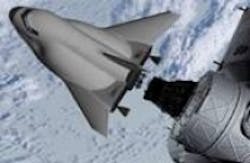Sierra Nevada Space Systems achieves milestones in NASA Commercial Crew program to build human spacecraft
“As the only company under contract to NASA for development of a Shuttle-like spacecraft, SNC is positioned to quickly restore U.S. capability to transport humans to the ISS after the Space Shuttle retires and to support other human spaceflight markets in low Earth orbit,” says a spokesperson.
The Systems Requirement Review (SRR), the first milestone completed under the CCDev2 program and a major step in the spacecraft’s development, validated SNC’s work based on NASA’s draft Commercial Crew Program Requirements. The SRR was completed on June 1, 2011 with participation by NASA and SNC industry partners. All the requirements were approved and will guide the design of the Dream Chaser to ensure that it meets the pending NASA certification requirements.
The second milestone, completed only two weeks after Milestone 1, was a review of the Dream Chaser’s improved airfoil fin shape, designed to improve the spacecraft handling qualities as it flies in the atmosphere on return from space to a gentle runway landing. Wind tunnel testing and computational fluid dynamics analyses were used to complete the fin selection milestone work.
“These were important milestones in our program, whose successful accomplishment sets the stage for completing significant work during the CCDev2 Program,” says Jim Voss, vice president of SNC’s Space Exploration. “NASA aerodynamicists, engineers, and managers from the Commercial Crew Program evaluated the work and participated as active participants in the review. The rapid development enabled by our partnership with NASA and the world class space companies on our team will ensure that our Nation retains its leadership in human spaceflight.”
The Dream Chaser is a lifting body spacecraft based on former NASA design, the HL-20 crew vehicle. Using SNC’s proprietary hybrid rocket motor technology, the Dream Chaser is a piloted or autonomous spacecraft which provides safe, reliable, and cost-effective transport of up to seven crew members or a combination of people and cargo to low-earth orbit and returning them safely to the Earth without excessive deceleration or landing forces.
